AD9548BCPZ Analog Devices Inc, AD9548BCPZ Datasheet - Page 48

AD9548BCPZ
Manufacturer Part Number
AD9548BCPZ
Description
IC CLOCK GEN/SYNCHRONIZR 88LFCSP
Manufacturer
Analog Devices Inc
Datasheet
1.AD9548BCPZ-REEL7.pdf
(112 pages)
Specifications of AD9548BCPZ
Input
*
Output
*
Frequency - Max
*
Voltage - Supply
*
Operating Temperature
*
Mounting Type
Surface Mount
Package / Case
88-LFCSP
Frequency-max
*
Clock Ic Type
Clock Synthesizer
Ic Interface Type
Serial
Frequency
1GHz
No. Of Outputs
4
No. Of Multipliers / Dividers
4
Supply Current
190mA
Lead Free Status / RoHS Status
Lead free / RoHS Compliant
Available stocks
Company
Part Number
Manufacturer
Quantity
Price
Part Number:
AD9548BCPZ
Manufacturer:
ADI/亚德诺
Quantity:
20 000
Company:
Part Number:
AD9548BCPZ-SMD7
Manufacturer:
SHARP
Quantity:
392
AD9548
A pause instruction, like an end instruction, is stored at the end
of a sequence of instructions in the scratch pad. When the
controller encounters a pause instruction during an upload
sequence, it keeps the EEPROM address pointer at its last value.
This way the user can store a new instruction sequence in the
scratch pad and upload the new sequence to the EEPROM. The
new sequence is stored in the EEPROM address locations
immediately following the previously saved sequence. This
process is repeatable until an upload sequence contains an end
instruction. The pause instruction is also useful when used in
conjunction with condition processing. It allows the EEPROM
to contain multiple occurrences of the same register(s), with
each occurrence linked to a set of conditions (see the EEPROM
Conditional Processing section).
To upload data to the EEPROM, the user must first ensure that
the write enable bit (Register 0E00, Bit 0) is set. Then, on setting
the autoclearing save to EEPROM bit (Register 0E02, Bit 0), the
controller initiates the EEPROM data storage process.
Uploading EEPROM data requires that the user first write an
instruction sequence into the scratch pad registers. During the
upload process, the controller reads the scratch pad data byte by
byte, starting at Register 0E10 and incrementing the scratch pad
address pointer as it goes until it reaches a pause or End
instruction.
As the controller reads the scratch pad data, it transfers the data
from the scratch pad to the EEPROM (byte by byte) and
increments the EEPROM address pointer accordingly, unless it
encounters a data instruction. A data instruction tells the
controller to transfer data from the device settings portion of
the register map to the EEPROM. The number of bytes to
transfer is encoded within the data instruction, and the starting
address for the transfer appears in the next two bytes in the
scratch pad.
When the controller encounters a data instruction, it stores the
instruction in the EEPROM, increments the EEPROM address
pointer, decodes the number of bytes to be transferred, and
increments the scratch pad address pointer. Then it retrieves the
next two bytes from the scratch pad (the target address) and
increments the scratch pad address pointer by 2. Next, the
controller transfers the specified number of bytes from the
register map (beginning at the target address) to the EEPROM.
When it completes the data transfer, the controller stores an
extra byte in the EEPROM to serve as a checksum for the
transferred block of data. To account for the checksum byte, the
controller increments the EEPROM address pointer by one
more than the number of bytes transferred. Note that, when the
EEPROM Upload
Rev. A | Page 48 of 112
controller transfers data associated with an active register, it
actually transfers the buffered contents of the register (see the
Buffered/Active Registers section for details on the difference
between buffered and active registers). This allows for the transfer
of nonzero autoclearing register contents.
Note that conditional processing (see the EEPROM Conditional
Processing section) does not occur during an upload sequence.
EEPROM Download
An EEPROM download results in data transfer from the
EEPROM to the device register map. To download data, the
user sets the autoclearing load from EEPROM bit (Register
0E03, Bit 1). This commands the controller to initiate the
EEPROM download process. During download, the controller
reads the EEPROM data byte by byte, incrementing the
EEPROM address pointer as it goes, until it reaches an end
instruction. As the controller reads the EEPROM data, it
executes the stored instructions, which includes transferring
stored data to the device settings portion of the register map
whenever it encounters a data instruction.
Note that conditional processing (see the EEPROM Conditional
Processing section) is only applicable when downloading.
Automatic EEPROM Download
Following a power-up, an assertion of the RESET pin, or a soft
reset (Register 0000, Bit 5 = 1), if FncInit[7:3] ≠ 0 (see the Initial
Pin Programming section), then the instruction sequence
stored in the EEPROM executes automatically with condition =
FncInit[7:3]. In this way, a previously stored set of register values
downloads automatically on power-up or with a hard or soft
reset. See the EEPROM Conditional Processing section for
details regarding conditional processing and the way it modifies
the download process.
EEPROM Conditional Processing
The condition instructions allow conditional execution of
EEPROM instructions during a download sequence. During
an upload sequence, however, they are stored as is and have
no effect on the upload process.
Note that, during EEPROM downloads, the condition instructions
themselves and the end instruction always execute unconditionally.
Conditional processing makes use of two elements: the condition
(from Condition 1 to Condition 31) and the condition tag
board. The relationships among the condition, the condition tag
board, and the EEPROM controller appear schematically in
Figure 50.














